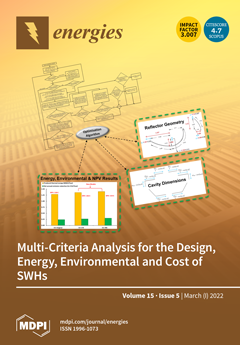A series of experiments were performed to investigate the effect of ignition energy (E
ig) and hydrogen addition on the laminar burning velocity (
Su0), ignition delay time (
tdelay), and flame rising time (
trising
[...] Read more.
A series of experiments were performed to investigate the effect of ignition energy (E
ig) and hydrogen addition on the laminar burning velocity (
Su0), ignition delay time (
tdelay), and flame rising time (
trising) of lean methane−air mixtures. The mixtures at three different equivalence ratios (
ϕ) of 0.6, 0.7, and 0.8 with varying hydrogen volume fractions from 0 to 50% were centrally ignited in a constant volume combustion chamber by a pair of pin-to-pin electrodes at a spark gap of 2.0 mm. In situ ignition energy (E
ig ∼2.4 mJ ÷ 58 mJ) was calculated by integration of the product of current and voltage between positive and negative electrodes. The result revealed that the
Su0 value increases non-linearly with increasing hydrogen fraction at three equivalence ratios of 0.6, 0.7, and 0.8, by which the increasing slope of
Su0 changes from gradual to drastic when the hydrogen fraction is greater than 20%.
tdelay and
trising decrease quickly with increasing hydrogen fraction; however,
trising drops faster than
tdelay at
ϕ = 0.6 and 0.7, and the reverse is true at
ϕ = 0.8. Furthermore,
tdelay transition is observed when E
ig > E
ig,critical, by which
tdelay drastically drops in the pre-transition and gradually decreases in the post-transition. These results may be relevant to spark ignition engines operated under lean-burn conditions.
Full article





